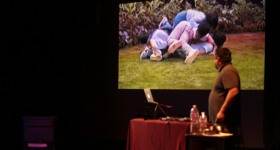Onstage, a turbaned Indian fakir and an exotic woman in shimmering skirts approach a statue of Ganesha, the elephant-headed Hindu deity. They light and swirl a stick of incense. A bell chimes. The fakir utters a Sanskrit incantation, Vakratunda mahakaya suryakoti samaprabha, nirvighnam kuru me deva, sarvakaresha sarvada.
The pair exits the stage.
Suddenly, the pompous voice of Yale ethnomagicologist Professor P.C. Carr breaks the spell. The white professor announces his mysterious guest from the Orient, who will perform magical wonders. The fakir, who is also a magician, re-enters the stage to a reverberating drumbeat. Without uttering a word, he juggles steel balls and sticks a large needle through his arm as Carr narrates.
Carr gesticulates grandly as he announces the next feat: sword swallowing! Sitting cross-legged, the magician displays a long, thin sword. He tilts his head back and slowly swallows the sword to the hilt.
The audience oohs.
As the magician pulls the sword out of his mouth, he reveals a rolled-up blade. He glares at Professor Carr and shouts, “Are you crazy? You bloodthirsty heathen! Do you really think I would do such a stupid and dangerous feat simply to amuse you?”
Welcome to the magic show of contemporary Indian jadoo artist Shreeyash Palshikar.
Reenacting a scene straight from Victorian-era magic performances, he plays up the mystical images of the East, only to shatter these stereotypes later.
While Palshikar’s main purpose, like that of all performers, is to entertain, he’s not the shiny-suited magician pulling scantily-clad women out of boxes. Instead, he walks on stage barefoot in a dhoti, shirt and turban but speaks with an American accent. He alludes to Hindu mythology yet gives off the skeptical air of a trained academic.
“The point is — what is floating in the air and why? Each object has a different connotation, a story I am telling about it,” says Palshikar. His audiences get tidbits about 19th-century Indian jugglers, Nepali Gurkha soldiers and Hindu creation myths. Palshikar aims to make his shows both fun and intellectually stimulating. “If you’re a 9-year-old kid and you watch it, it’s fun. If you happen to have a Ph.D. in cultural anthropology, it’s fun too,” he says.
In Search of a Magical India
Today’s India calls to mind images of outsourced tech centers and urban slums more than sword-swallowing conjurors. More than a century ago, however, a combination of tall tales from colonial travelers, Victorian-era spiritualism and innate human need for wonder conspired to create a Western vision of India as a magical land where just about anything could happen.
As historian Peter Lamont documents in The Rise of the Indian Rope Trick, Victorian colonialists exoticized their crown jewel. Mango trees sprouted from seed and bore fruit before one’s very eyes. Boys climbed ropes suspended in thin air followed by magicians who chopped them into pieces and threw their bloody parts on the ground, only to be magically whole again a moment later. Men and women floated weightlessly above the ground.
Ironically, as Indian magic gained currency in the West and was co-opted by Western magicians, traditional Indian magicians began to disappear.
“There’s been a steady degradation of Indian magicians,” says Palshikar, who studied this history for his doctoral qualifying paper on Indian magic at the University of Chicago. “For hundreds of years magicians were traveling entertainers in royal court in India. They had low social status, as all entertainers did, but were well paid for their art.”
But under colonial rule, the network of royal financial support for magicians collapsed. Today, Indian magicians are poor street performers. Even this group is diminishing because magician families want their children to leave the trade for more lucrative opportunities. “Traditional Indian street magic is a dying art,” Palshikar says.
This leaves people like Palshikar — academics and magic enthusiasts — to carry on the legacy.
Ancient Art, Modern Twist
Palshikar has long seen magic as part of his cultural heritage, though many Indian Americans don’t see magic this way. Growing up in the United States, his father took the family on multiple trips to India, where they celebrated Hindu religious festivals. On one of these trips, Palshikar witnessed a Western-style magic performance by his uncle. Palshikar became fascinated with magic as an art form.
“If you have real magical powers, then what you are doing has no skill at all,” says Palshikar. He never claims to have any real supernatural powers, whereas many traditional Hindu magicians do.
In his shows, Palshikar incorporates both Western and Indian elements through costume and set changes. He creates the raw atmosphere of street performances by performing tricks while seated on a mat accompanied by the beat of an Indian drum. However, unlike Indian magicians who have traditionally used the ground as a blind spot to keep certain maneuvers hidden from a standing audience, Palshikar performs onstage facing a seated audience. Like Western magicians, he uses the back of the stage as the audience’s blind spot. Translating Indian magic to a Western setting is part of the intrigue.
“Magic travels a lot better culturally than any other art form, just by the simple fact that it’s [seen as being] impossible,” says Palshikar.
The Oriental Speaks Back
“The Kundalini sho is risin’ tonight!” exclaims Palshikar onstage, sounding remarkably like a Southern Baptist preacher and eliciting a chuckle from the audience. He swallows loose needles and then pulls them out of his throat neatly threaded. He explains that in tantric yoga, Kundalini is the life force within the body envisioned as a snake that lives curled at the base of the spine. He demonstrates this force by making a single card selected by an audience member rise magically out of the deck. He juggles swords and mixes and then magically separates the colored sands of India. He conjures a rope from a basket with the sound of his snake charmer flute.
Throughout the course of his show, Palshikar morphs from the character of a mysterious Indian magician into a gregarious performer who both plays with and challenges Orientalist images. Starting out as a voiceless, exotic wonder-worker, Palshikar later talks back to the Western professor P.C. Carr, challenging his authoritative knowledge of the Orient.
“Just because somebody looks like they’re being Orientalized — in a certain costume, doing a certain thing — it doesn’t necessarily mean that they are being exploited or that they don’t know what’s going on,” Palshikar says. “I like to think of my audience as relatively intelligent. They see that I’m doing this with a wink, nudge, irony — they can understand that the rest of the show is taken with that approach.”
Just Pretend
“Performing artists serve as cultural ambassadors who can change the general public’s cultural stereotypes,” says Charisse Sisou, a professional belly dancer who plays the part of Princess Maya, the magician’s assistant. Usually, the female assistant in Western magic is a two-dimensional character with a pretty face who plays a passive role. “[We] sucker them in with magic and dance and comedy. It’s a lot of fun — it’s gentle and playful — but we’re also saying ‘Hey, maybe we can turn a few of these concepts around.’”
Princess Maya speaks and conspires with the other performers to trick an audience member into “buying her freedom.” Though fitting the mold of the pretty assistant, Sisou’s role also breaks the mold through her unexpected level of agency.
A decade ago, Palshikar’s shows were very different. He wasn’t as comfortable playing around with “Oriental” elements for fear of perpetuating negative stereotypes about Asians. Nowadays, Palshikar introduces emcees with British accents, posing as learned professors, who’ve brought a piece of the Orient for Western viewers to gawk at. He knows his audience will understand that he’s building this character only to point to his absurdity.
For his final act, Palshikar will lie on a bed of nails. “Whether you think it is done by yoga or is based on a physics principle of distribution of weight,” he tells the audience, “the bed of nails has entertained audiences worldwide for many decades.” Lying on a bed of nails was originally an act of religious devotion in Hindu temples before the British banned this practice. Later, Western carnival operators began including the trick in their shows.
Assistants demonstrate the sharpness of the nails by dropping fruit upon them. Once more, the pompous Professor Carr steps in to pontificate on the ascetic magician’s tantric powers, strengthened by celibacy.
Palshikar lowers himself onto the nail bed. Princess Maya stands on his chest, and later, another assistant smashes a cinder block on the supine magician.
The audience gasps.
Viewers suspend disbelief during the show and interpret the feat as a display of yogic spirituality, which doesn’t bother Palshikar. It’s part of the fun. He says, “That’s fine, as long as you know that I’m just pretending at the end of the show.”










Comments